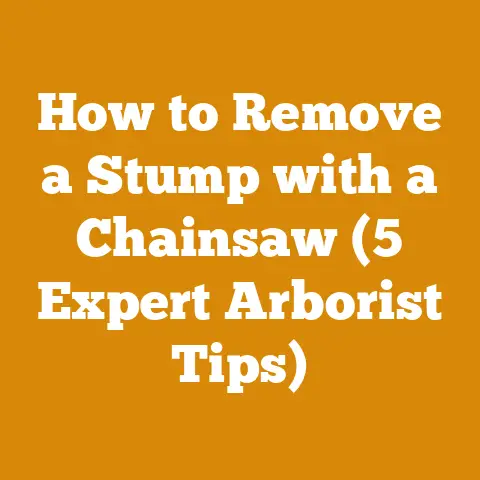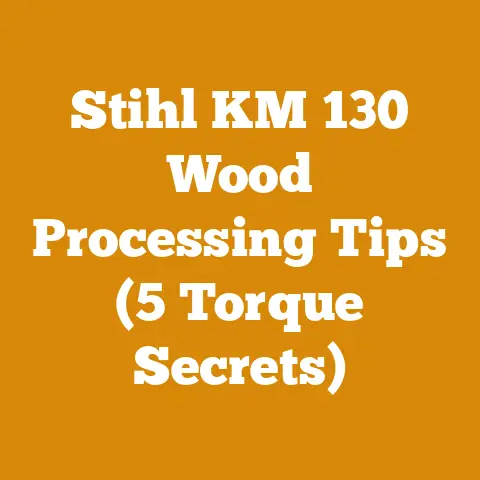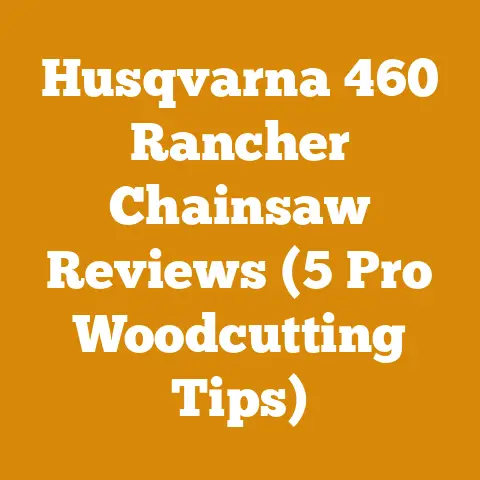Chainsaw Engine on Go-Kart (5 Pro Tips for Custom Builds)
Chainsaw Engine on Go-Kart (5 Pro Tips for Custom Builds)
The roar of a custom go-kart build is music to the ears of any DIY enthusiast.
But before you dive headfirst into creating your own unique ride, let’s talk about the elephant in the garage: cost.
Often overlooked, the financial aspect of a chainsaw engine go-kart project can quickly escalate if not carefully planned.
And while the thrill of tearing around on a machine you built yourself is undeniable, thinking about resale value from the outset is a smart move.
A well-executed, safe, and reliable go-kart can actually fetch a decent price if you ever decide to part ways with it.
I’ve seen meticulously crafted karts sell for more than the sum of their parts, simply because of the quality of the build and the perceived value of the customization.
In this article, I’m going to share my experiences and insights gleaned from years of tinkering with engines and metal, and detail how to build a chainsaw-powered go-kart on a budget.
We’ll break down the costs, discuss where you can save money, and highlight the areas where skimping is just not an option.
Why Chainsaw Engines for Go-Karts?
- Power-to-Weight Ratio: Chainsaw engines are designed to deliver high power in a compact and lightweight package.
This makes them attractive for go-kart applications where weight is a critical factor. - Availability and Cost: Used chainsaw engines can often be sourced relatively cheaply, especially from salvage yards or online marketplaces.
- Simplicity: These engines are typically air-cooled two-stroke or four-stroke designs, which are simpler to work on compared to more complex automotive engines.
Understanding the Real Cost: A Budget Breakdown
Building a chainsaw-powered go-kart isn’t just about bolting an engine to a frame.
It’s a project that demands meticulous planning, careful sourcing of parts, and, most importantly, a realistic budget.
I’ve seen too many projects stall halfway through because the builder underestimated the final cost.
I’m going to break down the potential expenses to help you plan your build.
1. The Engine: Heart of the Beast
- Used Chainsaw Engine: This is where most people start.
You can find used chainsaw engines on online marketplaces like eBay, Craigslist, or Facebook Marketplace.
Expect to pay anywhere from $50 to $300, depending on the engine’s size, condition, and brand.
For example, a used Stihl MS 291 engine, a popular choice for its power and reliability, typically ranges from $150 to $250. - New Chainsaw Engine: If you want guaranteed performance and reliability, a new engine is the way to go.
However, this will significantly increase your budget.
Expect to pay $300 to $800 for a new chainsaw engine, depending on the brand and specifications. - Engine Rebuild (If Needed): Don’t assume a used engine is ready to go.
It might need new piston rings, a carburetor rebuild, or other repairs.
Budget an additional $50 to $200 for potential engine rebuild costs.
A new piston and ring set for a Stihl MS 291, for example, costs around $40-$60.
Carburetor rebuild kits are generally $20-$40. - My Experience: I once bought a “bargain” chainsaw engine for $75.
It turned out the cylinder was cracked, and the cost of a replacement cylinder was more than buying a working used engine in the first place.
Lesson learned: thoroughly inspect any used engine before committing to the purchase.
2. The Go-Kart Frame: Foundation of Your Ride
- Used Go-Kart Frame: This is often the most cost-effective option.
Look for used go-kart frames on online marketplaces or from local go-kart tracks.
Prices typically range from $100 to $500, depending on the frame’s condition and features (e.g., suspension, roll cage). - New Go-Kart Frame Kit: If you want a clean slate, consider a new go-kart frame kit.
These kits usually include the frame, steering components, and sometimes even the axles and wheels.
Expect to pay $300 to $1000 for a new frame kit. - Fabricating Your Own Frame: This is the most challenging but potentially rewarding option.
You’ll need welding skills, metalworking tools, and a good understanding of go-kart geometry.
The cost of materials (steel tubing, welding wire, etc.) can range from $100 to $300. - Expert Insight: When choosing a frame, consider the wheelbase and track width.
A longer wheelbase provides better stability at higher speeds, while a wider track width enhances cornering performance.
Also, ensure the frame is strong enough to handle the power of your chainsaw engine.
3. Drivetrain: Power to the Wheels
- Clutch: You’ll need a centrifugal clutch to engage and disengage the engine from the drivetrain.
Expect to pay $30 to $100 for a centrifugal clutch, depending on its size and quality. - Chain and Sprockets: The chain and sprockets transfer power from the clutch to the rear axle.
The cost will vary depending on the chain size and the number of teeth on the sprockets.
Budget $20 to $50 for the chain and sprockets. - Axle and Bearings: The rear axle transmits power to the wheels.
You’ll need to purchase an axle, bearings, and bearing carriers.
Expect to pay $50 to $200 for the axle and bearings. - Cost-Saving Tip: Consider using a jackshaft to reduce the gear ratio between the engine and the rear axle.
This can improve acceleration and top speed.
A jackshaft kit typically costs $50 to $150.
4. Wheels and Tires: Where the Rubber Meets the Road
- Used Go-Kart Wheels and Tires: This is another area where you can save money.
Look for used go-kart wheels and tires on online marketplaces or from local go-kart tracks.
Expect to pay $50 to $200 for a set of used wheels and tires. - New Go-Kart Wheels and Tires: If you want the best performance and appearance, consider new go-kart wheels and tires.
Expect to pay $100 to $400 for a set of new wheels and tires. - Important Note: Choose tires that are appropriate for the type of terrain you’ll be driving on.
Slick tires are best for paved surfaces, while knobby tires are better for off-road use.
5. Steering and Brakes: Control is Key
- Steering Components: You’ll need a steering wheel, steering shaft, tie rods, and steering knuckles.
If you’re using a used go-kart frame, it may already have these components.
If not, expect to pay $50 to $200 for steering components. - Brakes: Brakes are essential for safety.
You can use either mechanical or hydraulic brakes.
Mechanical brakes are simpler and cheaper, but hydraulic brakes offer better stopping power.
Expect to pay $30 to $150 for brakes. - Safety First: Never compromise on the quality of your steering and braking components.
These are critical for controlling the go-kart and preventing accidents.
6. Miscellaneous Costs: The Devil’s in the Details
- Fuel Tank and Fuel Lines: You’ll need a fuel tank to hold the gasoline and fuel lines to connect the tank to the engine.
Expect to pay $20 to $50 for a fuel tank and fuel lines. - Throttle Cable and Linkage: You’ll need a throttle cable and linkage to control the engine’s throttle.
Expect to pay $10 to $30 for a throttle cable and linkage. - Kill Switch: A kill switch is a safety device that allows you to quickly shut off the engine in case of an emergency.
Expect to pay $5 to $20 for a kill switch. - Hardware (Nuts, Bolts, Washers): Don’t underestimate the cost of hardware.
You’ll need a variety of nuts, bolts, and washers to assemble the go-kart.
Budget $20 to $50 for hardware. - Safety Gear (Helmet, Gloves, Eye Protection): Safety gear is essential for protecting yourself while riding the go-kart.
Expect to pay $50 to $200 for a helmet, gloves, and eye protection. - Welding Supplies (If Needed): If you’re fabricating your own frame or modifying an existing one, you’ll need welding supplies, such as welding wire, welding rods, and shielding gas.
The cost of welding supplies can vary widely depending on the type of welding you’re doing.
7. Labor Costs: Your Time is Valuable (or Pay Someone Else)
- Your Time: If you’re building the go-kart yourself, your time is a valuable resource.
Factor in the time you’ll spend researching, sourcing parts, fabricating, and assembling the go-kart.
This is especially important if you’re taking time off work to complete the project. - Professional Labor: If you’re not comfortable fabricating or assembling the go-kart yourself, you can hire a professional to do it for you.
Expect to pay $50 to $100 per hour for professional labor.
Total Estimated Cost: A Realistic Assessment
Based on the above breakdown, here’s a realistic estimate of the total cost to build a chainsaw-powered go-kart:
- Budget Build (Using mostly used parts): $300 to $800
- Mid-Range Build (Using a mix of new and used parts): $800 to $1500
- High-End Build (Using mostly new parts and professional labor): $1500 to $3000+
It’s important to note that these are just estimates.
The actual cost of your project may vary depending on your specific choices and circumstances.
5 Pro Tips for Custom Builds
- Plan Meticulously: Before you even think about buying parts, create a detailed plan for your go-kart build.
This plan should include a parts list, a budget, and a timeline.
The more detailed your plan, the less likely you are to run into unexpected costs or delays. - Source Parts Wisely: Don’t just buy the first part you see.
Shop around and compare prices from different vendors.
Consider buying used parts to save money, but be sure to inspect them carefully before you buy. - Don’t Skimp on Safety: Safety is paramount.
Never compromise on the quality of your steering, braking, or safety gear.
These are the components that will protect you from injury in case of an accident. - Test and Refine: Once you’ve built your go-kart, don’t just take it out for a spin.
Test it thoroughly in a safe environment and make any necessary adjustments or repairs. - Learn from Others: There are many online forums and communities dedicated to go-kart building.
Take advantage of these resources to learn from the experiences of others.
Case Study: My Budget Chainsaw Go-Kart Build
A few years ago, I decided to build a chainsaw-powered go-kart on a shoestring budget.
I set a goal of spending no more than $500.
Here’s how I did it:
- Engine: I found a used Poulan chainsaw engine for $60 on Craigslist.
It needed a carburetor rebuild, which cost me another $20. - Frame: I salvaged a go-kart frame from a local scrapyard for $80.
It was rusty and dented, but structurally sound. - Drivetrain: I bought a used centrifugal clutch for $30, a chain and sprockets for $25, and an axle and bearings for $75.
- Wheels and Tires: I found a set of used go-kart wheels and tires for $50 on Facebook Marketplace.
- Steering and Brakes: I used the steering components from the salvaged go-kart frame.
I bought a set of mechanical brakes for $40. - Miscellaneous: I spent about $70 on miscellaneous items, such as a fuel tank, fuel lines, throttle cable, kill switch, and hardware.
In total, I spent $450 on my budget chainsaw go-kart build.
It wasn’t pretty, but it was functional and a lot of fun to drive.
Data and Statistics: The Economic Landscape of Go-Karting
While precise data on chainsaw-powered go-karts is limited, here’s some relevant information on the go-karting market:
- Global Go-Kart Market Size: According to a report by MarketWatch, the global go-kart market is projected to reach \$2.3 billion by 2026, growing at a CAGR of 3.5% from 2020 to 2026.
This indicates a growing interest in go-karting as a recreational activity. - Used Go-Kart Market: The used go-kart market is a significant segment of the overall go-kart market.
Prices for used go-karts vary widely depending on the condition, brand, and features. - DIY Go-Kart Community: There’s a thriving DIY go-kart community online, with numerous forums, websites, and social media groups dedicated to building and modifying go-karts.
This community provides a valuable resource for builders seeking advice, parts, and inspiration.
Calculations and Formulas: Power and Performance
Understanding some basic calculations can help you optimize the performance of your chainsaw-powered go-kart.
- Gear Ratio: The gear ratio is the ratio of the number of teeth on the driven sprocket to the number of teeth on the drive sprocket.
A lower gear ratio provides better acceleration, while a higher gear ratio provides better top speed.- Formula: Gear Ratio = (Number of Teeth on Driven Sprocket) / (Number of Teeth on Drive Sprocket)
- Engine Horsepower: You can estimate the horsepower of your chainsaw engine based on its displacement and RPM.
- Formula: Horsepower ≈ (Displacement in Cubic Inches x RPM) / 792,000 (This is a rough estimate and may vary depending on the engine’s design and tuning.)
- Top Speed: You can estimate the top speed of your go-kart based on the engine’s RPM, gear ratio, and tire diameter.
- Formula: Top Speed (MPH) = (Engine RPM x Tire Diameter in Inches x 60) / (Gear Ratio x 63,360)
Cost Optimization and Budget Management: Squeezing Every Penny
- Buy in Bulk: If you’re planning to build multiple go-karts or have friends who are also interested in building go-karts, consider buying parts in bulk to save money.
- Negotiate Prices: Don’t be afraid to negotiate prices with vendors, especially when buying used parts.
- Barter and Trade: Consider bartering or trading skills or services with other builders to save money.
- Recycle and Reuse: Look for opportunities to recycle and reuse materials, such as scrap metal or old tires.
- Track Your Spending: Keep a detailed record of your spending to stay on budget.
Challenges Faced by Small-Scale Go-Kart Builders
Small-scale go-kart builders often face several challenges:
Don’t forget to have fun along the way!
Conclusion: The Thrill of the Build
Building a chainsaw-powered go-kart is a challenging but rewarding project.
By carefully planning your build, sourcing parts wisely, and prioritizing safety, you can create a unique and exciting machine that will provide hours of fun.
Remember to think about resale value from the beginning, and build a go-kart that is not only fun to drive but also well-crafted and reliable.
And always, always prioritize safety.
The roar of that engine is a sweet sound, but it’s even sweeter when you know you’re in control and enjoying the ride responsibly.
Now get out there and build something amazing!






